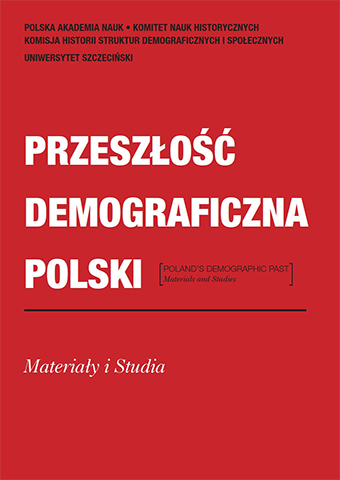| 1. | Augustyniak, Urszula. Testamenty ewangelików reformowanych w Wielkim Księstwie Litewskim w XVI–XVIII wieku, Warszawa: Semper, 2014. |
| 2. | Cummins, Neil. “Lifespans of the European Elite, 800–1800.” The Journal of Economic History 77, no. 2 (2017): 406–439. |
| 3. | Baten, Joerg, and Tom Keywood. “Elite Violence and Elite Numeracy in Europe from 500 to 1900 CE: A Co-Evolution?” (2019); from C.E.P.R. Discussion Papers, no. 14013. |
| 4. | Baten, Joerg, Mikołaj Szołtysek, and Monica Campestrini. “Girl Power” in Eastern Europe? The Human Capital Development of Central-Eastern Europe in the Seventeenth to Nineteenth Centuries and its Determinants.” European Review of Economic History 21, no. 1 (2017): 29–63. |
| 5. | David, Paul, S. Ryan Johansson, and Andrea Pozzi. “The Demography of an Early Mortality Transition: Life Expectancy, Survival and Mortality Rates for Britain’s Royals, 1500–1799.” University of Oxford Discussion Papers in Economic and Social History 83 (2010): 1–59. |
| 6. | Easterlin, Richard A. “The Worldwide Standard of Living Since 1800.” Journal of Economic Perspectives 14, no. 1 (2000): 7–26. |
| 7. | Feichtinger, Gustav, Maria Winkler-Dworak, Inga Freund, and Alexia Prskawetz. “On the Age Dynamics of Learned Societies–Taking the Example of the Austrian Academy of Sciences.” Vienna Yearbook of Population Research, Vienna Institute of Demography, Austrian Academy of Sciences (2007): 107–131. |
| 8. | Furtak, Tadeusz. “Kilka zagadnień z demografii historycznej szlachty polskiej.” Roczniki Dziejów Społecznych i Gospodarczych 4 (1937): 31–58. |
| 9. | Heimrath, Tadeusz. “Przełomy w rozwoju nowożytnego położnictwa uwarunkowane nowymi metodami postępowania.” In Społeczno-ideowe aspekty medycyny i nauk przyrodniczych XVIII–XX wieku, edited by Bożena Płonka-Syroka (series: Studia z Dziejów Kultury Medycznej, vol. 5), Wrocław: Oficyna Wydawnicza Arboretum, 2002. |
| 10. | Henry, Louis, and Claude Levy. “Ducs et pairs sous l’Ancien Régime: Caractéristiques démographiques d’une caste.” Population 15 (1960): 807–830. |
| 11. | Hollingsworth, Thomas H. “Mortality in the British Peerage Families Since 1600.” Population 32, no. 1 (1977): 323–352. |
| 12. | ———. “A Demographic Study of the British Ducal Families.” Population Studies 2, no. 1 (1957): 4–26. |
| 13. | ———. “The Demography of the British Peerage.” Population Studies vol. 18, no. 2 (1964), (Supplement): 1–108. |
| 14. | Huck, Paul. “Infant Mortality and Living Standards of English Workers During the Industrial Revolution.” Journal of Economic History 55, no. 3 (1995): 528–550. |
| 15. | Kędelski, Mieczysław. “Ewolucja umieralności i trwania życia ludności miasta Poznania w wiekach XIX i XX.” Studia Demograficzne 85 (1986): 3–26. |
| 16. | ———. “Piramida wieku i tablice trwania życia ludności Śląska w 1864 roku.” Przeszłość Demograficzna Polski 20 (1997): 49–71. |
| 17. | ———. “Umieralność i trwanie życia w Wielkopolsce w latach 1816–1875.” Przeszłość Demograficzna Polski 16 (1985): 109–138. |
| 18. | ———. Umieralność i trwanie życia ludności Wielkopolski w XIX wieku. Poznań: Akademia Ekonomiczna w Poznaniu, 1996. |
| 19. | Kuchowicz, Zbigniew. “Jeszcze o zdrowiu i niezdrowiu magnatów XVII–XVIII w.” Kwartalnik Historyczny 77, no. 2 (1970): 394–403. |
| 20. | Kuchowicz, Zbigniew. “Społeczne konsekwencje postępującej degeneracji możnowładztwa polskiego w XVII–XVIII w.” Kwartalnik Historyczny 76, no. 1 (1969): 21–43. |
| 21. | Lesiak, Anna. “Kobiety z rodu Radziwiłłów w świetle inwentarzy i testamentów (XVI–XVIII w.).” In Administracja i życie codzienne w dobrach Radziwiłłów XVI–XVIII wieku (“Fasciculi Historici Novi,” vol. IX), edited by Urszula Augustyniak, 119–130. Warszawa: Wydawnictwo DiG, 2009. |
| 22. | Lewis Judith. “’Tis a Misfortune to be a Great Ladie”: Maternal Mortality in the British Aristocracy, 1558–1959.” Journal of British Studies 37, no. 1 (1998): 31–32. |
| 23. | Liedke, Marzena. “Demografia rodziny magnackiej w Wielkim Księstwie Litewskim na tle elit zachodnioeuropejskich. Wybrane problemy.” Przeszłość Demograficzna Polski 37, no. 1 (2015): 37–70. |
| 24. | ———. “Rodzina magnacka.” In Rodzina i jej gospodarstwo na ziemiach polskich w geografii europejskich struktur rodzinnych do połowy XIX wieku, edited by Piotr Guzowski, and Cezary Kuklo, 173–218. Białystok: Instytut Badań nad Dziedzictwem |
| 25. | Kulturowym Europy 2019. |
| 26. | ———. “Śmierć magnata, czyli co liczby mogą powiedzieć o konsekwencji śmierci mężczyzny w rodzinie magnackiej w Wielkim Księstwie Litewskim w XVI–XVIII w.” Kwartalnik Historii Kultury Materialnej 60, no. 2 (2012): 271–282. |
| 27. | ———. Rodzina magnacka w Wielkim Księstwie Litewskim. Studium demograficzno–społeczne. Białystok: Instytut Badań nad Dziedzictwem Kulturowym Europy, 2016. |
| 28. | Lukowski, Jerzy. The European Nobility in the Eighteenth Century. New York: Palgrave Macmillan, 2003. |
| 29. | Peller, Sigismund. “Births and Deaths Among Europe’s Ruling Families Since 1500.” In Population in History. Essays in Historical Demography, edited by David V. Glass, David E.C. Eversley, 87–101. London: E. Arnold, 1965. |
| 30. | ———. “Mortality, Past and Future.” Population Studies 1 (1948), no. 4. |
| 31. | ———. “Studies on Mortality Since the Renaissance.” Bulletin of the History of Medicine part 1: 13 (1943): 422–461, part 2: 16 (1944): 362–281. |
| 32. | Piasecki, Edmund. Ludność parafii bejskiej (woj. kieleckie) w świetle ksiąg metrykalnych z XVIII–XX w. Studium demograficzne. Wrocław–Warszawa: PWN, 1990. |
| 33. | ———. “Próba sporządzenia okresowych tablic życia na podstawie ksiąg ruchu naturalnego w XVIII–XX w.” Przeszłość Demograficzna Polski 16 (1985): 139–151. |
| 34. | Płonka-Syroka, Bożena. Medycyna w historii i kulturze, Warszawa–Bellerive-sur-Allier: Wydawnictwo DiG, 2016. |
| 35. | Ragauskienė, Raimonda. Mirties nugalėti nepavyko: Biržų ir Dubingių Kunigaikščų Radvilų biologinė istorija (XV a. pabaiga–XVII a.), Vilnius: Lietuvos edukologijos universiteto leidykla, 2017. |
| 36. | Rostworowski Emanuel. “Zdrowie i niezdrowie polskich magnatów XVI–XVIII wieku.” Kwartalnik Historyczny 76, no. 4 (1969): 865–886. |
| 37. | Steckel, Richard H. “Biological Measures of the Standard of Living.” Journal of Economic Perspectives 22, no. 1 (2008): 129–152. |
| 38. | Stojek-Sawicka, Karolina. “Rola i miejsce lekarzy w życiu elit politycznych Rzeczypospolitej w epoce staropolskiej.” In Relacje lekarz–pacjent w aspekcie społecznym, historycznym i kulturowym, edited by B. Płonka-Syroka (series: Studia z Dziejów Kultury Medycznej, vol. 10), Warszawa: Wydawnictwo DiG, Oficyna Wydawnicza Arboretum, 2005. |
| 39. | Szołtysek, Mikołaj. Rethinking East-Central Europe: Family Systems and Co-residence in the Polish-Lithuanian Commonwealth. Bern: Peter Lang, 2015. |
| 40. | Szreter, Simon, and Graham Mooney. “Urbanization, Mortality, and the Standard of Living Debate: New Estimates of the Expectation of Life at Birth in Nineteenth–Century British Cities.” Economic History Review 51, no. 1 (1998): 84–112. |
| 41. | The Decline of Infant Mortality in Europe 1800–1950. Four National Case Studies, eds. C.A. Corsini. P.P. Viazzo, Florence: Unicef, 1993. Van Zanden, Jan Luiten, Joerg Baten, Marco Mira d’Ercole, Auke Rijpma, and Marcel P. Timmer. How Was Life? Global Well-being Since 1820, OECD publishing, 2014. |
| 42. | Vielrose, Egon. “Przyczynek do demografii szlachty polskiej.” Przegląd Statystyczny 1 (1938): 328–342. |
| 43. | Węglorz, Jakub. Zdrowie, choroba i lecznictwo w społeczeństwie XVI–XVIII wieku, Toruń: Wydawnictwo Adam Marszałek, 2015. |








